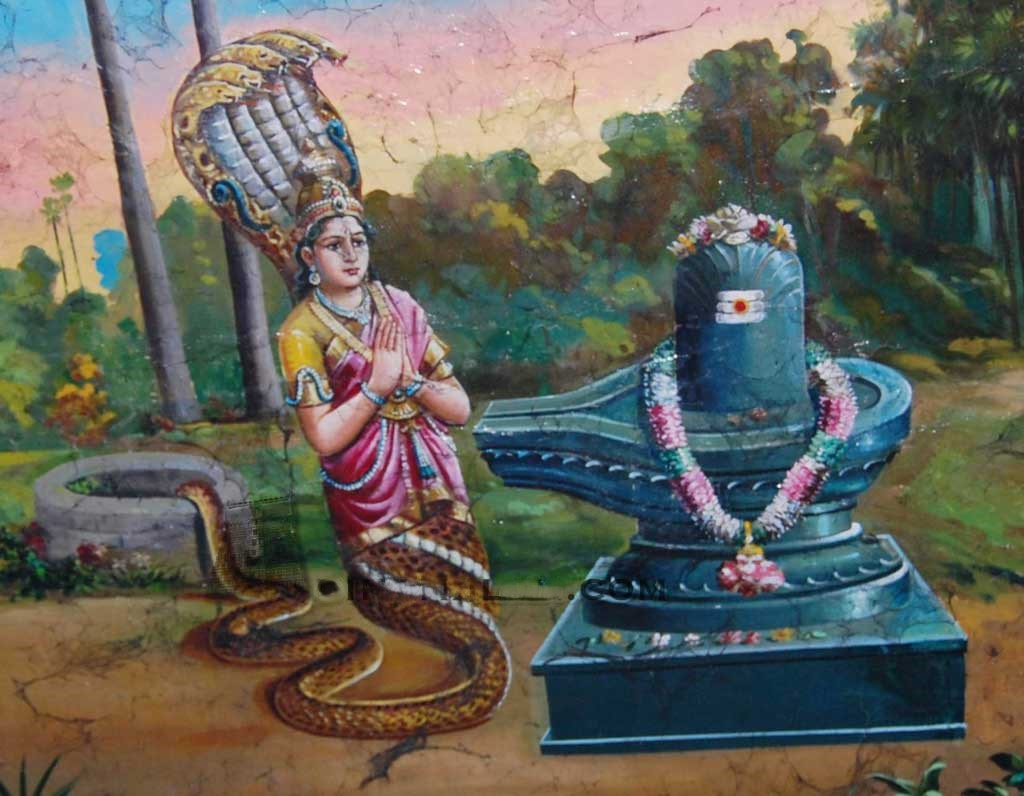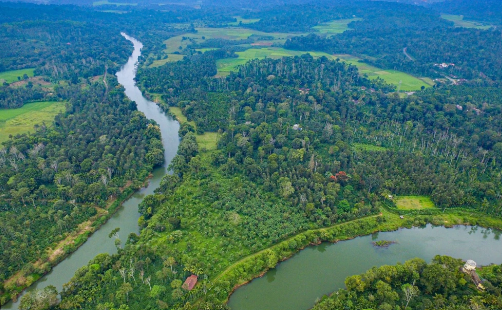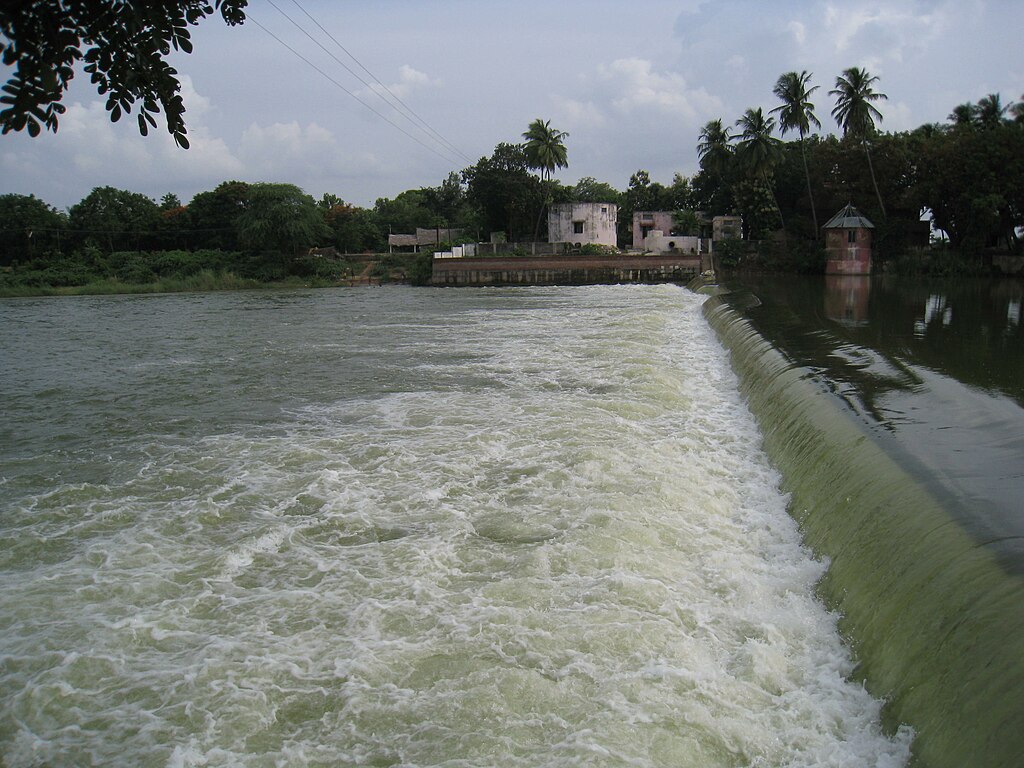- This is one of the 276 Devara Paadal Petra Shiva Sthalams and 39th Shiva Sthalam on the northern bank of the river Cauvery in Chozha Nadu (Vadakarai).
- This Temple is the 93rd Devara Paadal Petra Shiva Sthalam and 39th sthalam on the north side of river Cauvery in Chozha Nadu.
- Aruna Jadeswarar Temple is a Hindu Temple dedicated to Lord Shiva located in Thiruppanandal Town in Thiruvidaimaruthur Taluk in Thanjavur District in Tamil Nadu. Presiding Deity is called as Aruna Jadeswarar / Senjadai Appar / Senjadaiyar / Thaalavaneswarar / Jadaathar / Thaalapureeswarar / Panangaateeswarar and Mother is called as Brihan Nayagi / Periyanayaki / Thaalavaneswari.
- The temple is situated on the southern banks of Kollidam River.
PURANIC SIGNIFICANCE:
Thadagai Eswaram:
- Thadagai, a staunch Shiva devotee was unable to place her garland to Lord one day as her upper sari slipped.
- She held the sari with one hand and tried to place the garland with the other yet could not. Lord Shiva obliged his devotee by leaning his neck for her.
- The girl was happy to place the garland on the Lord. Since that day, the Shivalinga was always in a leaning posture.
- It is also said that she prayed to Lord Shiva to provide her with 16 hands to perform Shodasa Upachara pooja to him.
- Lord Shiva fulfilled her wish and granted her with 16 hands.
- There is a beautiful sculpture of Thadagai with 16 hands performing Pooja to Lord Shiva can be seen in the temple premises.
- As Thadagai worshipped Lord Shiva here, the place came to be called as Thadagai Eswaram.
Brahma Theertham:
- As per legend, once Lord Brahma (the Hindu God of creation) and Lord Vishnu (the Hindu God of Protection) had an argument in terms of supremacy.
- To test them, Lord Shiva pierced the three worlds as a huge endless pillar of light, the jyotirlinga.
- Vishnu and Brahma split their ways downwards and upwards respectively to find the end of the light in either direction.
- Lord Vishnu conceded his defeat.
- But Brahma lied that he saw the beginning of Shiva with the help of Thazhampoo (screw pine in English – is a type of flower).
- When Brahma was searching the Lord’s head, the flower from Shiva’s head was falling down.
- Brahma stopped the flower and convinced it to support him.
- He said he saw Shiva’s head and that is where he picked the flower to Shiva.
- Knowing the truth, Lord Shiva got angry and cursed Brahma that he would have no place on earth.
- He also cursed the Thazampoo to lose the importance of Shiva Pooja.
- Brahma realised his mistake and apologised to Shiva.
- He prayed to rescue him from the curse.
- Lord Shiva told him to go to Thirupananthal and worship him there after taking bath at the temple tank.
- Brahma did as per Lord Shiva’s instruction and got rid of dosha.
- Later Brahma became very happy as his curse was removed and he conducted a grand Yaga during the Tamil month of Chithirai.
- It is generally believed that every year Brahma comes down and conducts this Yaga personally during Chithirai.
- The temple tank in which Brahma took bath is called Brahma Theertham.
- Lord Shiva relieved Thazampoo also from the curse at this temple.
Brahma Theertham (Another story):
- Long ago there was a debate between Vishnu and Brahma about who is superior to the other.
- They went to Lord Shiva and asked him to solve their problem.
- Shiva told them that whoever is able to find his start and end (head and toe) is the winner.
- Lord Vishnu and Brahma started searching for his head and toe but they couldn’t find.
- On a “Shivaratri” day Shiva took the form of flame around midnight 12 o'clock.
- The time between 11:30 PM to midnight is called “Lingothbava Time” which is idle time to worship Shiva on Shivarathiri days.
- Lord Vishnu went to search Shiva’s end(Toe) and Brahma went to find Shiva’s start (Head).
- Lord Maha Vishnu and Brahma couldn’t find the start and end of Shiva.
- Vishnu accepted his defeat and told that he can’t find the end of Shiva.
- But Brahma lied that he saw the beginning of Shiva with the help of Thazhampoo (screw pine in English – is a type of flower).
- When Brahma was searching the Lord’s head the flower from Shiva’s head was falling down.
- Brahma stopped the flower and convinced it to support him.
- He said he saw Shiva’s head and that is where he picked the flower to Shiva.
- Knowing this entire event, Shiva got angry and cursed Brahma that he will not have any dedicated temple on earth.
- He also cursed the Thazhampoo to lose the importance in Shiva Pooja.
- Brahma realised his mistake and apologised with Shiva.
- He prayed to rescue him from the curse.
- Shiva told him to go to Thiruppananthal and worship Shiva there after taking bath at the temple tank.
- Brahma did as per Lord Shiva’s word and got rid of Dosha that is caused due to Lie.
- Later Brahma became very happy as his curse was removed and he conducted a grand Yaga during the Tamil month of Chithirai.
- It is generally believed that every year Brahma comes down and conducts this Yaga personally during Chithirai.
- The temple tank in which Brahma took bath is called Brahma Theertham.
- During the new moon day in tamil month of Aavani another grant festival celebrated at this temple is “Brahma Saba Nivarthi TheerthaVari”.
- Lord Shiva rescued Thazhampoo also from the curse at this temple.
- If the devotees worship Shiva and Devi at this temple, they will perform well in education.
- At this temple the god of Moon also worshipped Shiva and got rid of his Dosha.
- So anyone having Dosha from Moon also can worship here.
- The Ganesha at this shrine is called “Aanda Vinayagar”.
- To represent the Temple tree there are 2 Palmyra trees ( Borassus flabellifer) inside this temple.
Kungiliya Kalaya Nayanar:

- When a Chola king named Veerasenan renovated this temple, he tried to straighten the leaning posture of Shiva Linga with the help of his soldiers, but he could not succeed.
- They even used elephants to pull the Shivalinga to set it in order but failed.
- The king learned about Saint Kungiliya Kalaya Nayanar of Thirukkadaiyur and his devotion towards Lord Shiva.
- He called him here and sought his help.
- This Nayanar was famous because his worship always involved the use of the fragrant smoke of Kungiliyam (Benzoin).
- He tied a rope to the Lingam and to the other end of the rope he tied a knife.
- He wrapped the end with the knife to his neck and started pulling gently.
- He prayed to the Lord that in case he failed to straighten the lingam in this process, the Lord Shiva should take his life.
- Even as the rope tightened around his neck, the Nayanar did not flinch.
- Lord Shiva did not want to test Nayanar any further and returned the Lingam back to its straightened position.
- The king paid rich tributes to Nayanar and honoured him with gifts.
Nagakannikai Theertham:
As per legend, the son of Kungiliya Kalaya Nayanar died in this place. It is believed that when he was taken for cremation, Lord Vinayakar intercepted and advised them to bathe his son in the waters of the Nagakannikai Theertham. When they did so, Nayanar's son was restored back to life.
Thiru Pananthal:
It is believed that Lord Shiva is said to have emerged under the Palm tree (Panai Maram).
Hence, the place came to be called Thiru Pananthal.
Thala Vanam:
Thiruppanandal was also called as Thala Vanam in ancient times.
Thala means Palm Tree and Vanam means forest.
Upadesa Sthalam:
It is believed that Goddess Parvathy worshipped Lord Shiva here and received Gnana Upadesa (divine learning).
As she received Upadesa from Lord Shiva, their shrines are facing each other.
Hence, the temple is considered as Upadesa Sthalam.
Naga Kanni worshipped Lord Shiva here:

Naga Kanni (Sumathi), daughter of Vasuki and her husband Arithuvasan from the Naga Loka worshipped Lord Shiva of this Temple.
Lord Shiva visits the Brahma Theertham on Aavani New Moon Day:
It is believed that Lord Shiva visits the Brahma Theertham of this temple on the Aavani new moon day in August-September.
Chandra worshipped Lord Shiva here:
It is believed that Chandra worshipped Lord Shiva to get rid of a Dosha.
Anyone having Chandra dosha can worship Lord Shiva for relief.
People worshipped Lord Shiva here:
It is believed that Mother Parvathi, Iravadha, white elephant of Lord Indra, Indra, Surya, Chandran, Sage Agastya, Adisesha, Thadagai, Kungiliya Kalaya Nayanar, Sangu Kannan, Nagu Kannan, Naga Kannikas, Lord Brahma and Vishnu had worshipped Lord Shiva in this temple.
495aa3.png)

